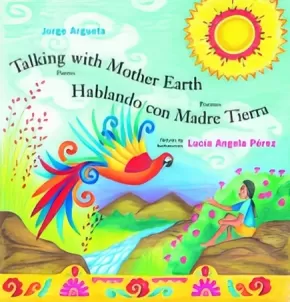Spanish
Kids Books (2)
Synopsis:
A collection of poetry by one of the greatest Indigenous poets of the Americas about the vanished world of his childhood — that of the Maya K’iche’.
Aquí era el paraíso / Here Was Paradise is a selection of poems written by the great Maya poet Humberto Ak’abal. They evoke his childhood in and around the Maya K’iche’ village of Momostenango, Guatemala, and also describe his own role as a poet of the place.
Ak’abal writes about children, and grandfathers, and mothers, and animals, and ghosts, and thwarted love, and fields, and rains, and poetry, and poverty, and death.
The poetry was written for adults but can also be read and loved by young people, especially in this collection, beautifully illustrated by award-winning Guatemalan-American illustrator Amelia Lau Carling.
Ak’abal is famous worldwide as one of the great contemporary poets in the Spanish language, and one of the greatest Indigenous poets of the Americas. Ak’abal created his poems first in K’iche’, then translated them into Spanish.
Educator Information
Recommended for ages 9+.
Dual-language in English and Spanish.
Key Text Features: foreword, biographical information, poems, translation
Correlates to the Common Core State Standards in English Language Arts:
CCSS.ELA-LITERACY.RL.4.2
Determine a theme of a story, drama, or poem from details in the text; summarize the text.
CCSS.ELA-LITERACY.RL.5.4
Determine the meaning of words and phrases as they are used in a text, including figurative language such as metaphors and similes.
CCSS.ELA-LITERACY.RL.5.5
Explain how a series of chapters, scenes, or stanzas fits together to provide the overall structure of a particular story, drama, or poem.
CCSS.ELA-LITERACY.RL.5.7
Analyze how visual and multimedia elements contribute to the meaning, tone, or beauty of a text (e.g., graphic novel, multimedia presentation of fiction, folktale, myth, poem).
CCSS.ELA-LITERACY.RL.6.2
Determine a theme or central idea of a text and how it is conveyed through particular details; provide a summary of the text distinct from personal opinions or judgments.
CCSS.ELA-LITERACY.RL.6.5
Analyze how a particular sentence, chapter, scene, or stanza fits into the overall structure of a text and contributes to the development of the theme, setting, or plot.
Excerpt from the Introduction by Patricia Aldana: "In this book we find poems about children, and grandfathers, and mothers, and animals, and ghosts, and thwarted love, and fields, and rains, and poetry, and poverty, and death. Ak'abal never pretended that life in his world was easy. The history of Guatemala is complex. It has the highest Indigenous population as a percentage of any country in the Americas. And Maya people have suffered terrible discrimination, violence and poverty since the arrival of the Europeans. But Ak'abal's poems convey how all his world's elements also came together to create a deep, rich reality.... Reading these wonderful poems can remind us that it is still possible to fight to protect this beautiful world and the people who live in and on it."
Additional Information
172 pages | 6.50" x 8.31" | 14 Colour Illustrations | Hardcover | Translated by Hugh Hazelton
Synopsis:
Raw, honest and powerful, these moving bilingual poems by noted Salvadoran poet Jorge Argueta explore a young native boy's connection to Mother Earth and how he is healed from the terrible wounds of racism he has endured. Tetl has learned from his grandmother about the spirituality of his ancestors, about how they viewed the earth as alive with sacred meaning. This helps him move from doubt and fear, created by the taunts of other children, to self-acceptance and a discovery of his love for nature.
Mountains, wind, corn and stones all speak to Tetl, almost seeming to vibrate with life. He feels deep roots in them and, through them, he learns to speak and sing. They reveal his Nahuatl self and he realizes that he is special, beautiful and sacred.
These gripping poems have something to teach us all, perhaps especially those who have been either intentionally or casually cruel or racist, as well as those who have been the victims of racism.
Crudos, honestos e impactantes, estos conmovedores poemas bilingües por el aclamado salvadoreño Jorge Argueta exploran la relación de un joven nativo con la Madre Tierra y de como fue curado de las terribles heridas causadas por el racismo que ha tenido que aguantar. Tetl ha aprendido de su abuela sobre la espiritualidad de sus ancestros, sobre como ellos veían la tierra como un ser vivo con un sentido sagrado. Esto lo ayuda a pasar de la duda y el miedo, creado por las burlas de los otros niños, a la aceptación de sí mismo y al descubrimiento de su amor por la naturaleza.
La montañas, el viento, el maíz y las piedras le hablan a Tetl, parece casi que vibran de vida. El siente profundas raíces en ellos, a través de ellos, y aprende a hablar y cantar. Ellos le revelan su parte Náhuatl y él se da cuenta de que es especial, bello y sagrado.
Estos poemas apasionantes tienen algo que enseñarnos a todos, quizás especialmente a aquellos que intencionalmente o sin quererlo han sido crueles o racistas, como también a aquellos que a su vez han sido víctimas del racismo.
Additional Information
36 pages | 8.94" x 9.56"







